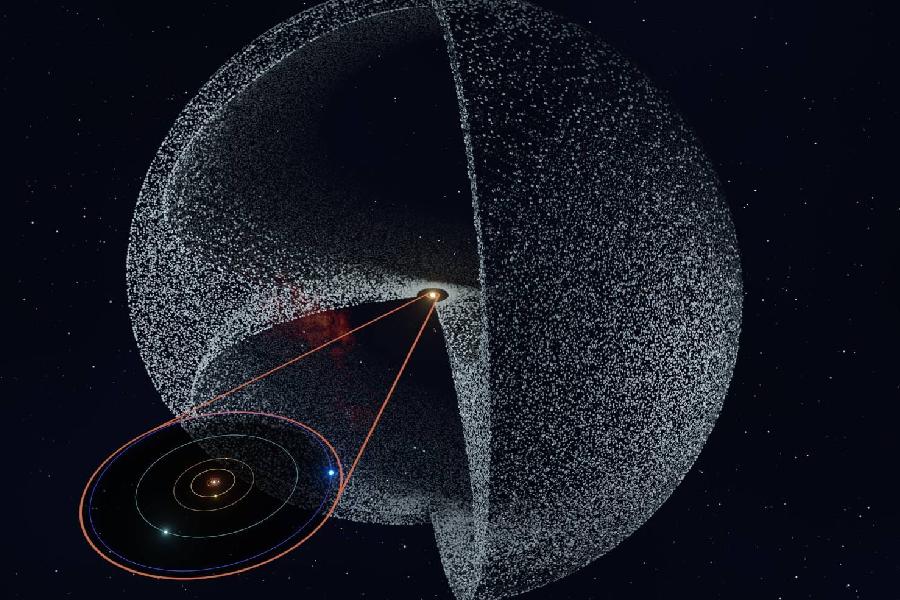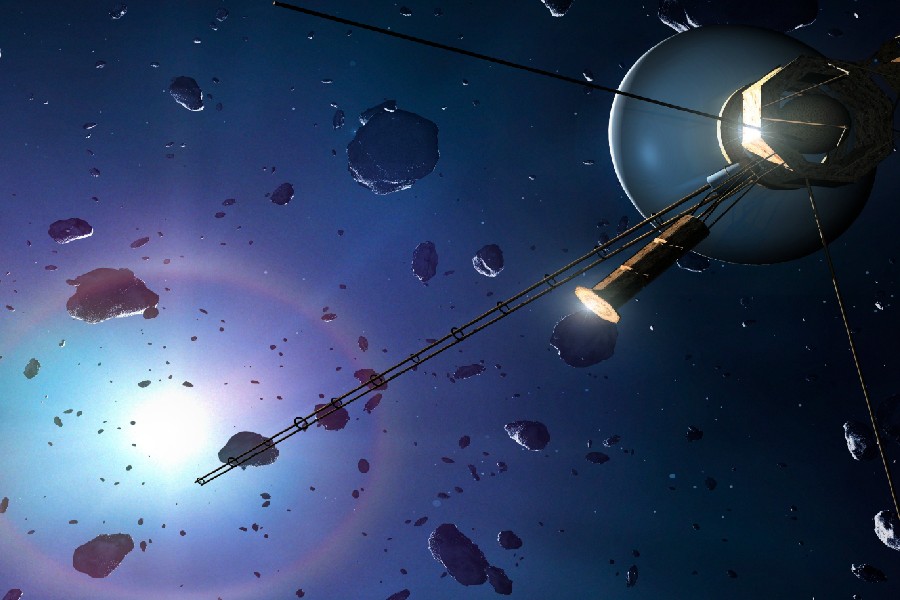Floating far beyond Pluto lies a hypothesized spherical shell of icy bodies and dust encompassing our solar system. This is called the Oort Cloud by our astronomers. But what is the Oort Cloud? Why is the Oort Cloud important?
In this article, we will unravel the Oort Cloud’s history as inferred from comet visitors, hinting towards a shared deep space origin. We also examine astrophysical models that hypothesize how the Oort Cloud could have taken shape in the early solar nebula immediately following the formation of our Sun.
Brace yourself as we dive deeper into the definition of Oort Cloud, this postulated icy cloud’s nature, origins, contents, and dynamic behavior. Let’s get started!
What Is the Oort Cloud?
The Oort Cloud is a hypothetical region in the outermost reaches of our solar system, believed to be a vast, spherical shell of icy objects. This also includes comets and other small celestial bodies.
While it has not been directly observed, its presence is inferred from the trajectories of long-period comets that occasionally enter the inner solar system from its distant depths. The Oort Cloud is considered a reservoir of primitive, icy bodies that may preserve clues about the early solar system’s formation.
Furthermore, a Dutch astronomer, Jan Oort, proposed the existence of the Oort Cloud in 1950. It is thought to extend far beyond the orbits of the most distant planets like Neptune and Pluto.

Jan Oort and the Oort Cloud Hypothesis
Biography of Jan Oort
The astronomer Jan Hendrik Oort pioneered radio astronomy and galactic studies in the 20th century. Born in the Netherlands in 1900, he confirmed the Milky Way’s rotation and mapped its spiral structure.
By analyzing light spectra, Oort identified chemical variations in gasses between stars. He also categorized comets into two primary types related to orbital periods, known as the Oort Cloud and Hills Cloud types, linked to his pioneering work.
However, his most speculative contribution came in 1950 upon analyzing incoming icy visitor orbits over prior decades. Noting their semi-major axes showed no tendency to cluster, plus trajectories tilting randomly, unlike orderly planets, Oort knew something was amiss.
This led him to propose a giant hypothetical origin reservoir of cometary bodies orbiting up to 50,000 AU away on average – now called the Oort Cloud. This inference explained puzzling observations about long-period comets while potentially doubling the Sun’s dominion.
Formation of the Hypothesis
Astronomers recorded occasional comet sightings for centuries, but their origins remained mysterious. Periodic, short-range comets like Halley were explained by orbital resonance with giant planets. Yet the trajectories of long-period comets made little sense based on known planetary physics in the mid-20th century.
Upon calculating these oddballs’ orbital elements, Oort realized their semi-major axes distribution appeared too homogeneous for them all to originate from the same region in space. Moreover, their orbital planes tilted randomly rather than aligning with the solar system’s overall ecliptic plane.
This led him to correctly infer long-period comets must hail from some unknown, detached spherical cloud far beyond Pluto – now bearing his name. While this proposal seemed exotic before computers could model orbital dynamics, improved calculations have vindicated Oort’s once-controversial pioneered hypothesis.
Location and Extent of the Oort Cloud
Beyond Neptune
The Oort Cloud is theorized to occupy an immense spherical bubble around our solar system’s familiar neighborhoods. Models suggest that its innermost edge may start as close as 1,000 AU from the Sun, more than 20 times farther away than distant Neptune.
Most of this diffuse icy cache orbits between 2,000 and 5,000 AU, as indicated by computational models considering populations required to produce observed long-period comets. These models help us understand the dynamics of this distant region in our solar system.
Yet, the hypothesized Oort cloud may extend its farthest tendrils up to 200,000 AU away by some calculations – 1/5th the distance between stars. Such remoteness hints at the earliest debris remnants lingering relatively undisturbed after the Sun’s initial stellar nursery days.
Oort’s Spherical Shell
Jan Oort proposed a theoretical spherical distribution for the paths of objects in the Oort Cloud. This was in stark contrast to the relatively flat, orderly orbital architecture of the inner solar system.
So, the Oort Cloud doesn’t form a central bulge of material. Instead, it wraps the solar system in a lopsided hollow bubble shape, tilted slightly relative to the ecliptic plane.
The implications suggest a shared formation history for the cometary bodies populating this shell – distinct from the planetary accretion process. Dynamic early scattering events may have pumped traditional Kuiper Belt members outward while ejecting developing planetesimals from disruptions in tidy concentric orbits.
Over millions of years, these complementary mechanisms work together. They could populate a ragged yet globally encapsulating Oort sphere, as suggested by models.

Composition of the Oort Cloud Objects
Icy bodies
What is found in the Oort Cloud? As the name suggests, the Oort Cloud consists predominantly of small, frozen icy bodies ranging in size from dust grains up to dwarf planet-scale objects estimated within the largest size bracket.
Furthermore, models predict a range of icy mixtures likely based on provenance within gas giant planet formation zones. And densities allow more volatile ices to cling despite weak gravitational binding so far out.
Also, analysis of arriving long-period comets offers some composition insights – materials like water ice, methane, ammonia, carbon dioxide, and cyanogen compounds liberate as erupting vapor upon solar approach. Spectroscopy of outbound cometary tails reveals these ingredients.
Comets and more
The Oort Cloud is a vast repository for the nuclei of long-period comets that are occasionally dislodged and sent sunward. Perturbations by passing stars or galactic tides provide rare gravitational triggers for inbound icy wanderers after millions of years undisturbed.
Models suggest that more than just comets likely lurk as a fraction may be trapped Kuiper Belt objects flung outward early on. These objects are now creeping slowly in a spherical orbit, a ‘halo’.
Moreover, collision remnants too small to withstand freeze-thaw cycles this far out would be preserved unchanged from the dawn of our stellar system’s birth.
Oort Cloud vs. Kuiper Belt
Distinguishing features
The Oort Cloud and Kuiper Belt contain icy objects orbiting the Sun but differ significantly in their locations and configurations. The Kuiper Belt forms a thick disk of bodies beyond Neptune’s orbit, extending from about 30 to 50 AU from the Sun. On the other hand, the hypothesized Oort Cloud occupies an outer spherical shell at an enormous 2,000 to 200,000 AUs distance.
While Kuiper Belt orbits remain relatively aligned to the ecliptic plane, Oort Cloud comet trajectories tilt randomly. Also, Kuiper objects exhibit more stable, circular orbits lacking disruptions seen in long-period comets originating from the Oort Cloud’s fringes.
Shared origins
Some models propose that the Oort Cloud and Kuiper Belt shared kinship in the earliest epochs after the Sun ignited fusion. As the primordial accretion disk coalesced into planets, it may have ejected debris outwards over time. This process could have gradually populated the farther Oort Sphere with scattered long-period comets and established the nearer Kuiper Belt’s mass as known today.
So, while displaying some parallels in icy content, the two regions likely were shaped by different processes given their radically divergent architectures. Studying both offers compound views into the solar system’s history billions of years ago.

Differences Between Long-Period Comets and Short-Period Comets
Comets display a range of orbital properties based on their points of origin. Short-period comets like Halley originate from the Kuiper Belt or scattered disc. It cycles through periods less than 200 years with trajectories still influenced by giant planets Jupiter and Neptune.
In contrast, long-period comets have elongated orbits exceeding 200 years, hinting at a more detached, distant source no longer swayed by known planetary gravity. Jan Oort analyzed incoming long-period comet paths to reveal their semi-major axes showed no tendency to cluster at certain values – evidence of a roughly spherical distribution.
Plus, their orbital planes tilted randomly, unlike the relatively aligned Kuiper Belt sources closer in. These signatures led to Oort correctly inferring long-period comets originate from a hypothetical vast, detached cloud of debris enclosing our solar system.
Hence, short-period comets owe their existence to our stellar neighborhood as we know it today. On the other hand, long-period comets offer glimpses even further back toward material leftover from the primordial accretion disk that failed to coalesce into planets 4.6 billion years ago.
The Outer Edge of Our Solar System, Interstellar Space, and Galactic Tides
Median estimates position the main Oort Cloud inner band at approximately 2,000 AU, with potential outer fringe tendrils extending as far as 100,000 AU. This frontier extends astonishingly close to interstellar space. External gravitational influences can more easily disrupt the Sun’s otherwise dominant grip at such distances.
Furthermore, the Milky Way’s galactic tides provide the largest periodic perturbing force, ramping up during regular ~30 million-year passages through the star-dense galactic plane. Also, while statistically rare over eons, close stellar flybys within a few lightyears may trigger comet showers by significantly torquing trajectories. It’s a dynamic tug-of-war between our star’s gravity and sporadic visitors.
While mostly undisturbed, if one imagines the timescale spans between occasional nudges, the Sun’s outermost denizens still orbit along a ragged precipice. They are not entirely bound to the planet’s orderly world, yet they are not fully independent galactic vagabonds.
Conclusion
What is the Oort Cloud? We unpacked the case for the Oort Cloud’s existence – a hypothesized, detached population of icy bodies surrounding our solar system. While direct confirmation lies over the horizon, contemplating what a cloud of planetary leftovers from our stellar nursery era implies about origins and architecture intrigues the imagination.
We have illuminated its outermost region by surveying facets such as theorized structure, orbital dynamics, object composition, mass estimates, and ties to occasional long-period comets. This provides insights into what it may reveal about early solar system influences.
As technology progresses, tracing an arriving comet to its Oort Cloud source may offer definitive proof of this alleged shared past hanging over us among the stars.
